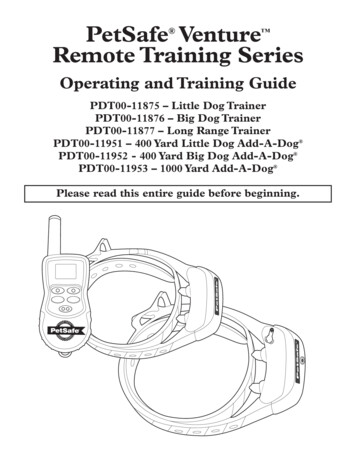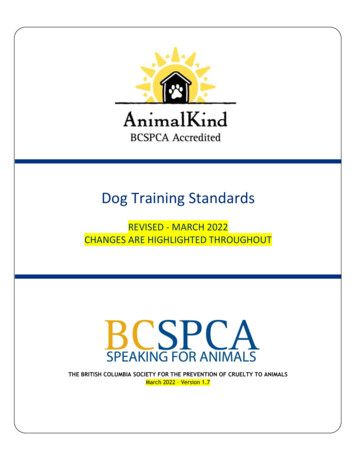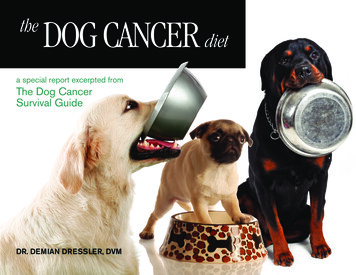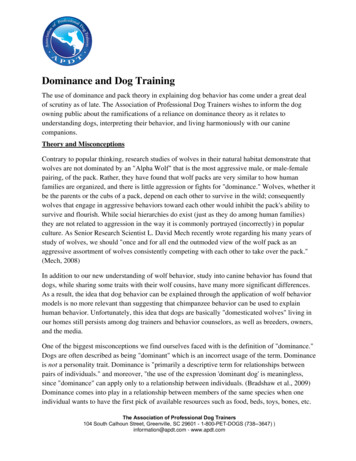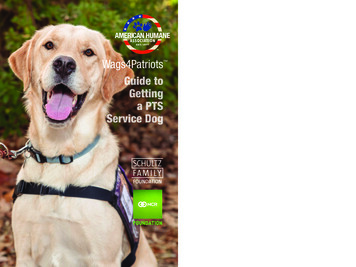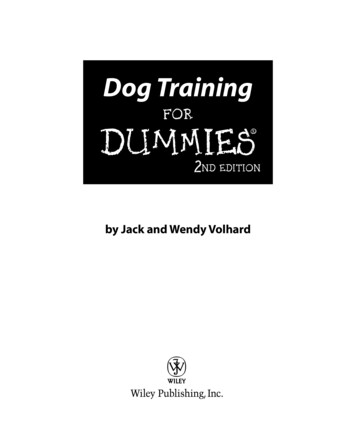
Transcription
Dog TrainingFORDUMmIES‰2NDEDITIONby Jack and Wendy Volhard
Dog TrainingFORDUMmIES‰2NDEDITION
Dog TrainingFORDUMmIES‰2NDEDITIONby Jack and Wendy Volhard
Dog Training For Dummies , 2nd EditionPublished byWiley Publishing, Inc.111 River St.Hoboken, NJ 07030-5774www.wiley.comCopyright 2005 by Wiley Publishing, Inc., Indianapolis, IndianaPublished by Wiley Publishing, Inc., Indianapolis, IndianaPublished simultaneously in CanadaNo part of this publication may be reproduced, stored in a retrieval system, or transmitted in any form orby any means, electronic, mechanical, photocopying, recording, scanning, or otherwise, except as permitted under Sections 107 or 108 of the 1976 United States Copyright Act, without either the prior writtenpermission of the Publisher, or authorization through payment of the appropriate per-copy fee to theCopyright Clearance Center, 222 Rosewood Drive, Danvers, MA 01923, 978-750-8400, fax 978-646-8600.Requests to the Publisher for permission should be addressed to the Legal Department, Wiley Publishing,Inc., 10475 Crosspoint Blvd., Indianapolis, IN 46256, 317-572-3447, fax 317-572-4355, or online athttp://www.wiley.com/go/permissions.Trademarks: Wiley, the Wiley Publishing logo, For Dummies, the Dummies Man logo, A Reference for theRest of Us!, The Dummies Way, Dummies Daily, The Fun and Easy Way, Dummies.com and related tradedress are trademarks or registered trademarks of John Wiley & Sons, Inc. and/or its affiliates in the UnitedStates and other countries, and may not be used without written permission. All other trademarks are theproperty of their respective owners. Wiley Publishing, Inc., is not associated with any product or vendormentioned in this book.LIMIT OF LIABILITY/DISCLAIMER OF WARRANTY: THE PUBLISHER AND THE AUTHOR MAKE NO REPRESENTATIONS OR WARRANTIES WITH RESPECT TO THE ACCURACY OR COMPLETENESS OF THE CONTENTS OF THIS WORK AND SPECIFICALLY DISCLAIM ALL WARRANTIES, INCLUDING WITHOUTLIMITATION WARRANTIES OF FITNESS FOR A PARTICULAR PURPOSE. NO WARRANTY MAY BE CREATEDOR EXTENDED BY SALES OR PROMOTIONAL MATERIALS. THE ADVICE AND STRATEGIES CONTAINEDHEREIN MAY NOT BE SUITABLE FOR EVERY SITUATION. THIS WORK IS SOLD WITH THE UNDERSTANDING THAT THE PUBLISHER IS NOT ENGAGED IN RENDERING LEGAL, ACCOUNTING, OR OTHERPROFESSIONAL SERVICES. IF PROFESSIONAL ASSISTANCE IS REQUIRED, THE SERVICES OF A COMPETENT PROFESSIONAL PERSON SHOULD BE SOUGHT. NEITHER THE PUBLISHER NOR THE AUTHORSHALL BE LIABLE FOR DAMAGES ARISING HEREFROM. THE FACT THAT AN ORGANIZATION ORWEBSITE IS REFERRED TO IN THIS WORK AS A CITATION AND/OR A POTENTIAL SOURCE OF FURTHERINFORMATION DOES NOT MEAN THAT THE AUTHOR OR THE PUBLISHER ENDORSES THE INFORMATION THE ORGANIZATION OR WEBSITE MAY PROVIDE OR RECOMMENDATIONS IT MAY MAKE.FURTHER, READERS SHOULD BE AWARE THAT INTERNET WEBSITES LISTED IN THIS WORK MAY HAVECHANGED OR DISAPPEARED BETWEEN WHEN THIS WORK WAS WRITTEN AND WHEN IT IS READ.For general information on our other products and services, please contact our Customer CareDepartment within the U.S. at 800-762-2974, outside the U.S. at 317-572-3993, or fax 317-572-4002.For technical support, please visit www.wiley.com/techsupport.Wiley also publishes its books in a variety of electronic formats. Some content that appears in print maynot be available in electronic books.Library of Congress Control Number: 2005924073ISBN-13: 978-0-7645-8418-3ISBN-10: 0-7645-8418-9Manufactured in the United States of America10 9 8 7 6 5 4 3 2 12O/RR/QX/QV/IN
About the AuthorsJack and Wendy Volhard share their home with two Labrador Retrievers, aLandseer Newfoundland, three Standard Wirehaired Dachshunds, and onecat. The dogs are more or less well-trained, depending on who you ask, andthe cat does his own thing. All are allowed on the furniture, but do get offwhen told. The Volhards are true practitioners — they have obtained morethan 50 conformation and performance titles with their dogs.Through their classes, lectures, seminars and training camps in the UnitedStates, Canada, and England, the Volhards have taught countless owners howto communicate more effectively with their pets. Individuals from almost everystate and 15 countries have attended their training camps. Veterinarians,breeders, trainers, and dog owners like you, regularly consult them on questions about behavior, heath, nutrition, and training. Internationally recognizedas “trainers of trainers,” they’re also award-winning authors, and their bookshave been translated into three languages. This is their ninth book.In addition to their work together, both Jack and Wendy are well recognizedin the training community for their individual accomplishments.Jack is the recipient of five awards from the Dog Writers’ Association ofAmerica (DWAA) and an American Kennel Club obedience judge for 30 years.He’s the author of more than 100 articles for various dog publications andsenior author of Teaching Dog Obedience Classes: The Manual for Instructors,knows as “the bible” for trainers, and Training Your Dog: The Step-by-StepManual, named Best Care and Training Book for 1983 by the DWAA.Wendy is the recipient of four awards from the DWAA. She’s the author ofnumerous articles, a regular columnist for the American Kennel Gazette, andco-author of five books, including the Canine Good Citizen: Every Dog Can beOne, named Best Care and Training Book for 1995 by the DWAA, and TheHolistic Guide for a Healthy Dog, now in its second edition.Wendy, whose expertise extends to helping owners gain a better understanding of why their pets do what they do, developed the Canine PersonalityProfile, and her two-part series, “Drives — A New Look at an Old Concept,”was named Best Article for 1991 in a Specialty Magazine by the DWAA. Shealso developed the most widely used system for evaluating and selectingpuppies, and her film, Puppy Aptitude Testing, was named Best Film on Dogsfor 1980 by the DWAA. Wendy specializes in behavior, nutrition, and alternative sources of healthcare for dogs, such as acupuncture and homeopathy,and has formulated a balanced homemade diet for dogs.
DedicationThis book is for those who like their dogs and who have them first and foremost as pets and companions.Authors’ AcknowledgmentsAll of us are the product of our life experiences. Our life experiences withdogs started in the 1960s, when we were exposed to many of the famousbehaviorists of the day. Being avid readers, we absorbed as much information as we could from individuals such as Konrad Most, Konrad Lorenz, andEberhard Trummler. We discovered why dogs do what they do and how toapply a behavioral approach to training, one that copies how dogs interactwith each other. John Fuller’s work at Bar Harbor, Maine, and ClarencePfaffenberger’s with Guide Dogs for the Blind, as well as the experimentsdone in Switzerland by Humphrey and Warner to indicate the working abilities of German Shepherds, all went into the mix that eventually became ourMotivational Method of training.Since the 1960s, we have had nine generations of dogs and all of them havebeen our teachers. We ran an obedience school for 25 years, and all the students and their dogs have been our teachers as well. We continue today withtraining, seminars, and camps, and we’re fortunate to be presented withenough dog challenges to continue our quest for knowledge. So to all of youwho have passed through our hands, we thank you and your dogs for providing us with the interest that still drives us today.Our special thanks to those who contributed to this book and shared theirinsights: Betsy Blackford, Sheila Hamilton-Andrews, Jane Kelso and the beautiful Labradors of Mountain Run Kennel, Desmond and Lise O’Neill, HilarySchenk, Danny and Pauline Scott, Gary Wilkes, and Mary Ann Zeigenfuse.Finally, we thank our editors at Wiley Publishing — Acquisitions Editor TracyBoggier, Tech Editor Michael Eldridge, Project Editor Natalie Harris, and CopyEditors Chad Sievers and Trisha Strietelmeier. They have demonstrated the twomost important qualities of a good dog trainer — patience and persistence.
Publisher’s AcknowledgmentsWe’re proud of this book; please send us your comments through our Dummies online registrationform located at www.dummies.com/register/.Some of the people who helped bring this book to market include the following:Acquisitions, Editorial, andMedia DevelopmentProject Editor: Natalie Harris(Previous Edition: Michael Kelly)Acquisitions Editor: Tracy BoggierCopy Editors: Chad Sievers,Trisha StrietelmeierEditorial Program Assistant: Courtney AllenComposition ServicesProject Coordinator: Shannon SchillerLayout and Graphics: Carl Byers,Joyce Haughey, Heather Ryan,Julie TrippettiProofreaders: Leeann Harney,Jessica Kramer, Carl William Pierce,TECHBOOKS Production ServicesIndexer: TECHBOOKS Production ServicesGeneral Reviewer: Michael Eldridge(Previous Edition: Mary Ann Zeigenfuse)Senior Permissions Editor: Carmen KrikorianEditorial Manager: Michelle Hacker(Previous Edition: Pam Mourouzis)Editorial Assistant: Hanna Scott,Melissa BennettCover Photos: Abbie Enneking/2005Interior Photos: Jack and Wendy Volhard,except as indicatedCartoons: Rich Tennant(www.the5thwave.com)Publishing and Editorial for Consumer DummiesDiane Graves Steele, Vice President and Publisher, Consumer DummiesJoyce Pepple, Acquisitions Director, Consumer DummiesKristin A. Cocks, Product Development Director, Consumer DummiesMichael Spring, Vice President and Publisher, TravelKelly Regan, Editorial Director, TravelPublishing for Technology DummiesAndy Cummings, Vice President and Publisher, Dummies Technology/General UserComposition ServicesGerry Fahey, Vice President of Production ServicesDebbie Stailey, Director of Composition Services
Contents at a GlanceIntroduction .1Part I: Training for You and Your Dog .7Chapter 1: Recognizing Why Dog Training Is Important .9Chapter 2: Setting the Stage for Training .21Chapter 3: Surviving the Puppy Period .39Chapter 4: Housetraining .51Chapter 5: Understanding Your Dog’s Mind .65Chapter 6: Equipping for Training Success .83Chapter 7: Mastering Basic Training .95Chapter 8: Canine Cruise Control: Walking, Coming When Called,and Leaving Stuff Alone .109Part II: Giving Your Dog’s Training Its Best Shot .123Chapter 9: Developing Training Savvy .125Chapter 10: Dealing with Doggie Don’ts .145Chapter 11: Dealing with Aggression .161Chapter 12: Preparing for Your Dog’s Citizenship Test .175Part III: Training for Competition .187Chapter 13: Getting Ready to Compete .189Chapter 14: The Companion Dog Title .211Chapter 15: Retrieving .227Chapter 16: The Companion Dog Excellent Title .241Chapter 17: The Utility Dog Title .259Part IV: Beyond Training: AddressingYour Dog’s Needs .283Chapter 18: Feeding Your Dog .285Chapter 19: Understanding Your Dog’s Health .307Chapter 20: Seeking Expert Outside Help .317
Part V: The Part of Tens .325Chapter 21: Ten (Okay, Eleven) Fun and Exciting Sporting Activities .327Chapter 22: Ten Basic Commands Every Dog Needs to Know .339Chapter 23: Ten Reasons Why Dogs Do What They Do .343Chapter 24: Ten (or So) Tricks for Fun and Gains .349Index .363
Table of ContentsIntroduction .1About This Book .2Conventions Used in This Book .2What You’re Not to Read .3Foolish Assumptions .3How This Book Is Organized .4Part I: Training for You and Your Dog .4Part II: Giving Your Dog’s Training Its Best Shot .4Part III: Training for Competition .4Part IV: Beyond Training: Addressing Your Dog’s Needs .4Part V: The Part of Tens .5Icons Used in This Book .5Where to Go from Here .6Part I: Training for You and Your Dog .7Chapter 1: Recognizing Why Dog Training Is Important . . . . . . . . . . . .9Identifying a Well-Trained Dog .10Identifying the Basic Five Commands .11The “Sit” command .11The “Go Lie Down” command .11The “Down” command .12The “Come” command .12The “Easy” command .12Just Who Is Training Whom? .13Understanding the YOU Factor .14Knowing your expectations .14Knowing your attitude .16Figuring Out How Your Dog Thinks .17“Reading” your dog .17When you don’t read your dog in time .18Tackling distractions .19Exploring Advanced Training for Fun and Competition .19The Novice, Open, and Utility classes .20The Canine Good Citizen Certificate .20Agility, Rally Obedience, and more .20More than Training: Understanding How Dogs Help People .20
xiiDog Training For Dummies, 2nd EditionChapter 2: Setting the Stage for Training . . . . . . . . . . . . . . . . . . . . . . . .21Selecting a Training Model .22Traditional training .24Clicker training .27Establishing Trust with Your Dog .29Being consistent with commands and tone of voice .30Outlasting your dog — be persistent .31Knowing to avoid “no” .31Repeating commands .32Taking charge .32Assuming Your Role as Pack Leader .34Placing your dog in a Sit and Down .34The Long Sit and Down exercise: A recipe for leadership .36Chapter 3: Surviving the Puppy Period . . . . . . . . . . . . . . . . . . . . . . . . . .39Understanding Your Puppy’s Socialization Needs .40The weaning period: Weeks 3-7 .40Getting to know everyone: Weeks 7-12 .42Suddenly he’s afraid: Weeks 8-12 .43Now he wants to leave home: Beyond 12 weeks .43Managing the Terrible Twos .45Surviving the juvenile flakies .45Puppy discovers sex .46When hormones kick in, it’s not always about sex .47Spaying or Neutering .48Knowing when to spay or neuter .49Disadvantages to spaying and neutering .49Finally He Grows Up .50Chapter 4: Housetraining . . . . . . . . . . . . . . . . . . . . . . . . . . . . . . . . . . . . . .51Using a Crate: A Playpen for Your Puppy .51Finding the right crate .53Coaxing Buddy into the crate .53Helping Buddy get used to the crate .54Identifying the Fundamentals of Housetraining Your Puppy .55Set up an elimination schedule .55Establish a regular toilet area .56Keep your eyes open for signs .57An accident is an accident is an accident .58Be ready for regressions .59What to do if you catch Buddy in the act .59How to train an adult dog .59What to do about an apartment dog .59Using an Exercise Pen for Housetraining .60Managing Marking Behavior .61Traveling by Car with Buddy .63
Table of ContentsChapter 5: Understanding Your Dog’s Mind . . . . . . . . . . . . . . . . . . . . . .65Recognizing Your Dog’s Instinctive Behaviors .65Prey drive .66Pack drive .67Defense drive .69How the drives affect training .70Determining Your Dog’s Personality Profile .71Deciding How You Want Buddy to Act .74Bringing out drives .76Switching drives .76Applying drives to your training .78Chapter 6: Equipping for Training Success . . . . . . . . . . . . . . . . . . . . . .83Choosing the Right Training Equipment .84Pulling on leashes .84Choosing among collars .85Hedging toward head halters .91Treats Are Your Training Buddies .93Selecting the ideal treat .93When treats don’t work .94Chapter 7: Mastering Basic Training . . . . . . . . . . . . . . . . . . . . . . . . . . .95The First Step: Leash Training Your Dog .96Teaching the Basics .96Sitting .96Staying .98Playing the Sit-Stay game .100Releasing: The magic word is “Okay” .101Getting the dog down (but not out) .102Go lie down, doggy! .103Dashing Your Dog’s Dashing Habits .104Door and stair manners .104The doorbell and guests .105Setting the Tone for Proper Table Manners .107Chapter 8: Canine Cruise Control: Walking, Coming When Called,and Leaving Stuff Alone . . . . . . . . . . . . . . . . . . . . . . . . . . . . . . . . . . . . .109Walking Your Dog .110Born to pull .110Heeling on leash .111Changing direction .114Changing pace .115Winning the Game of Coming When Called .116Training Buddy to come when called .117Adding distractions .118Advancing to off-leash distractions .119Mastering the “Leave It” Command .120xiii
xivDog Training For Dummies, 2nd EditionPart II: Giving Your Dog’s Training Its Best Shot .123Chapter 9: Developing Training Savvy . . . . . . . . . . . . . . . . . . . . . . . . .125Managing Your Dog’s Environment .125Starting on the right foot .126Recognizing your dog’s social needs .126Identifying your dog’s emotional needs .127Feeding your dog’s nutritional needs .128Managing the Dog Within .129Breed-specific behaviors .129Temperament .131Mental sensitivity .132Responses to visual stimuli .132Sound sensitivity .134Touch sensitivity .134Stressing the Stressful Effects of Stress .135Understanding stress .135Recognizing the symptoms of stress .137Origins of stress — intrinsic and extrinsic .137Relating stress to learning .138Stress and distraction training .140Managing Stress .140Managing positive stress .141Managing negative stress .141Other remedies for managing stress .141Chapter 10: Dealing with Doggie Don’ts . . . . . . . . . . . . . . . . . . . . . . .145Figuring Out the Cause of Behavior Problems .146Exercise .146Good company .147Good health .147Good nutrition .148Good training .148Dealing with Your Dog’s Objectionable Behavior .148Tolerating your dog’s behavior problems .149Trying to solve your dog’s behavior problems .150Finding a new home for your dog .150Taking a one-way trip to the pound .151Digging the Scene .151Barking Up Any Tree .152Barking as a response .153Barking for no apparent reason .153Chewing — The Nonfood Variety .154The physiological need to chew .154The psychological need to chew .155
Table of ContentsCoping with Separation Anxiety .155The desensitizing approach .156The D.A.P. approach .156Soiling the House .157Dribbling, or Submissive Wetting .158Suffering from Carsickness .159Chapter 11: Dealing with Aggression . . . . . . . . . . . . . . . . . . . . . . . . . .161What Is Aggressive Behavior? .161Looking at the Causes of Aggression .163Managing Your Dog’s Aggression —Prey, Pack, Fight, and Flight Drives .164Aggression from dogs high in prey drive .165Aggression from dogs high in fight drive .165Aggression from dogs high in pack drive .169Feeding and Aggression .171Dealing with Fear-Biters — Dogs High in Flight Drive .
Joyce Pepple, Acquisitions Director, Consumer Dummies Kristin A. Cocks, Product Development Director, Consumer Dummies Michael Spring, Vice President and Publisher, Travel Kelly Regan, Editorial Director, Travel Publishing for Technology Dummies Andy Cummings, Vice President and Publisher, Dumm

